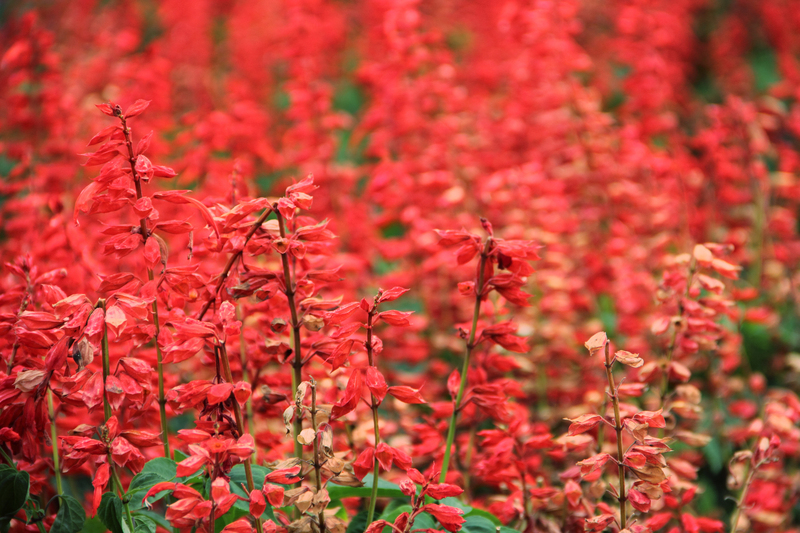Turning Table Scraps into Lush, Fertile Ground
Posted on 16/06/2025
Turning Table Scraps into Lush, Fertile Ground: The Ultimate Guide to Composting at Home
Are you searching for a sustainable way to reduce food waste while enriching your garden? Turning table scraps into lush, fertile ground is not just an eco-friendly choice--it's a transformative journey that closes the loop between your kitchen and your outdoor spaces. By learning to compost kitchen scraps, you create a green cycle that benefits the earth, your wallet, and your garden. In this comprehensive guide, we'll explore everything you need to know about converting food waste into dark, nutrient-rich soil, ensuring your home becomes part of the solution, not the problem.

Why Compost Table Scraps?
Every year, millions of tons of table scraps and kitchen waste end up in landfills, where they decompose anaerobically and produce harmful methane gas--a significant contributor to climate change. But what if we told you that these humble food remnants could be transformed into a potent, natural fertilizer instead? Composting is a simple, cost-effective, and rewarding way to revitalize your soil while playing a role in global sustainability efforts.
- Environmental Impact: Diverting kitchen scraps from landfills reduces greenhouse gas emissions.
- Soil Health: Compost enriches the earth, improves water retention, and supports healthy plant growth.
- Economic Benefits: Reducing reliance on chemical fertilizers saves money and promotes organic gardening.
The Science Behind Turning Table Scraps into Fertile Ground
When you compost food waste, you're encouraging natural decomposition. In the right conditions, microorganisms and beneficial insects break down organic material into humus--a dark, earthy matter packed with nutrients. This process mimics nature's own recycling system, where nothing goes to waste, and every nutrient finds its way back to the soil.
Getting Started: The Essentials of Composting Table Scraps
Before you transform your table scraps into fertile ground, let's gather the basics:
- Location: Choose a spot in your yard or garden for a compost pile or bin. It should be well-drained and partially shaded.
- Compost Bin or Pile: While simply making a heap works, bins keep things neater and aid in faster decomposition.
- Material Mix: Compost requires a balance of browns (carbon-rich materials) and greens (nitrogen-rich kitchen scraps).
- Tools: A garden fork or shovel for turning, a kitchen pail for collection, and a water source.
What Table Scraps Can You Compost?
Not all kitchen waste is created equal. For optimal compost, focus on these compostable table scraps:
- Fruit and vegetable peels
- Coffee grounds and tea leaves
- Eggshells (crushed for faster breakdown)
- Bread (in moderation)
- Cooked pasta or rice (plain, without sauces)
Avoid: Dairy, meat, oils, and cooked foods with sauces as they attract pests and slow decomposition.
The Carbon-Nitrogen Balance
A thriving compost pile relies on the proper balance of carbon ("browns") and nitrogen ("greens").
- Greens: Fresh table scraps, coffee grounds, grass clippings
- Browns: Dried leaves, cardboard, shredded newspaper, twigs
Tip: Aim for a ratio of about 2-3 parts browns to 1 part greens for effective composting.
Step-by-Step Guide to Composting Table Scraps at Home
1. Collect Your Kitchen Scraps
Set up a container or pail with a lid in your kitchen to store fruit and vegetable peels, coffee grounds, and other compostable table scraps. Empty it into your outdoor compost bin regularly to prevent odors and pests.
2. Add Brown Materials
Each time you deposit food waste, cover it with a generous layer of browns such as dry leaves or shredded newspaper. This not only balances the carbon-nitrogen ratio but also deters pests and controls odors.
3. Build Layers
Alternate layers of greens (table scraps) and browns. This structure helps aerate the pile and speeds up the breakdown process.
4. Maintain Moisture
Your compost pile should be as damp as a wrung-out sponge. Water when dry, but avoid overwatering, which can slow decomposition and create unpleasant smells.
5. Turn the Pile
Mix the pile with a garden fork every 1-2 weeks. Turning aerates the composting material and ensures microorganisms get the oxygen they need to thrive.
6. Wait and Use
Compost is usually ready in 3-6 months. You'll know it's done when the material looks like dark, crumbly soil and smells earthy. Sift out large pieces to return to the pile for further decomposition.
Troubleshooting Your Compost
Even seasoned composters encounter challenges. Here's how to solve the most common issues as you turn table scraps into fertile ground:
- Bad Odors: Usually the result of too many greens or poor aeration. Add browns and turn the pile.
- Pests: Avoid meat, dairy, and oily foods. Cover new additions with brown materials.
- Slow Decomposition: The pile may be too dry or lack nitrogen. Moisten and add more greens.
- Matted Layers: Shred materials and alternate layers between wet and dry items.
Best Practices for Efficient Kitchen Scrap Composting
To maximize the benefits of turning table scraps into lush, fertile ground, consider these expert tips:
- Cut or Shred Table Scraps: Smaller pieces break down faster, reducing composting time.
- Monitor the Pile: Check temperature by feeling the pile's center. Warmth means active decomposition.
- Store Browns Year-Round: In autumn, stockpile leaves or shredded paper for use throughout the year.
- Use Compostable Bags: For convenience, kitchen caddies can be lined with certified compostable bags that break down in the pile.
Vermicomposting: Harnessing Worms for Faster Results
If you don't have outdoor space, try vermicomposting: using worms to turn food scraps into fertile soil. Worm bins are compact, odor-free, and produce rich castings perfect for indoor and outdoor plants. Add kitchen scraps, bedding (shredded paper), and red wiggler worms to a ventilated bin. Harvest worm castings after a few months for a supercharged fertilizer.
The Benefits of Using Homemade Compost
Applying home-composted table scraps to your garden beds, planters, or lawn creates a host of benefits:
- Improved Soil Structure: Compost lightens heavy clay and adds body to sandy soil.
- Enhanced Nutrient Content: Provides slow-release nutrients, reducing the need for synthetic fertilizers.
- Increased Biodiversity: Healthy soil harbors beneficial microbes, earthworms, and insects.
- Water Retention: Compost acts like a sponge, helping soils hold moisture and reducing the need for frequent watering.
*Gardeners notice bigger harvests, brighter blooms, and fewer plant diseases--proving the power of turning everyday waste into garden gold!
Creative Ways to Use Compost in the Garden
- Top Dressing: Spread compost around trees, shrubs, and perennials to nourish plants and suppress weeds.
- Soil Amendment: Mix into garden beds before planting to boost fertility and microbial life.
- Potting Mix: Blend with soil and sand for nutrient-rich potting mixes for houseplants and seedlings.
- Mulch: Apply a thick layer around plants to retain moisture and prevent weed growth.
Composting Table Scraps: Myths vs. Facts
- Myth: Composting is complicated and time-consuming.
Fact: With a simple system, composting is easy, quick, and fits right into daily routines. - Myth: Compost piles always smell bad.
Fact: Well-managed piles with the right balance of browns and greens are virtually odor-free. - Myth: You need a lot of space.
Fact: Anyone can compost, whether you have a backyard, patio, or just a kitchen corner for vermicomposting.
Composting Innovations: Modern Solutions for Urban Dwellers
Apartment and city residents can still contribute to the composting revolution:
- Bokashi Bins: Ferment food waste (even meat and dairy) in sealed buckets using beneficial microbes. The result can be buried in soil or added to a traditional compost pile.
- Community Composting: Many cities offer drop-off points or curbside pickup for kitchen scraps, making it easy to recycle food waste collectively.
- Electric Composters: These countertop appliances rapidly dehydrate and grind food waste into a soil amendment in hours.

Growing a Greener Future, One Table Scrap at a Time
The choice to transform table scraps into lush, fertile ground is simple yet profound. Each banana peel, coffee ground, and carrot top destined for your compost is a vote for healthier soil, cleaner air, and a more sustainable home. The process fosters a deeper connection with the rhythms of nature--a daily reminder that waste is just a resource waiting for rebirth.
Whether you're a seasoned gardener or a city dweller taking your first step, you can master the art and science of home composting. With minimal effort and maximum reward, you'll discover that turning kitchen waste into rich soil is not just about saving the planet--it's about nourishing the landscapes, plants, and communities right outside your door.
Start composting today and see your world bloom, from vegetable beds to flowerpots--all nurtured by the power of upcycled table scraps.
Frequently Asked Questions about Turning Table Scraps into Fertile Ground
-
Q: Can I compost citrus peels and onion skins?
A: Yes, both are compostable. However, use them in moderation, as they can take longer to break down and, in excess, may deter earthworms. -
Q: How can I prevent rodents or bugs from infesting my compost pile?
A: Bury fresh scraps under brown materials, avoid meat and oily foods, and consider animal-proof bins if pests are a problem. -
Q: My compost is too wet and stinky--what should I do?
A: Add more dry "browns," turn the pile for aeration, and reduce the amount of wet food waste temporarily. -
Q: What do I do with finished compost?
A: Spread it on your garden beds, blend with potting mix, or around ornamental plants for a lush, thriving landscape.
Remember: Turning table scraps into lustrous, fertile earth is an empowering, planet-loving act everyone can do. Transform your habits today, and enjoy a garden that thanks you with every bloom and harvest!

